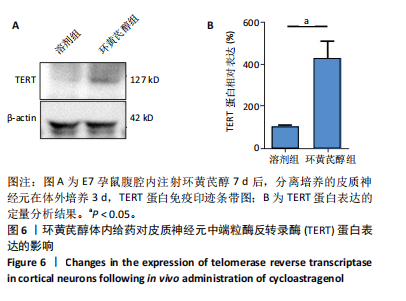[1] GORDON EM, CHAUVIN RJ, VAN AN, et al. A somato-cognitive action network alternates with effector regions in motor cortex. Nature. 2023;617(7960):351-359.
[2] DE CARVALHO M, SWASH M. Upper and lower motor neuron neurophysiology and motor control. Handb Clin Neurol. 2023;195:17-29.
[3] INOUE R, NISHIMUNE H. Neuronal Plasticity and Age-Related Functional Decline in the Motor Cortex. Cells. 2023;12(17):2142.
[4] YU Y, ZHOU L, YANG Y, et al. Cycloastragenol: An exciting novel candidate for age-associated diseases. Exp Ther Med. 2018;16(3): 2175-2182.
[5] LI M, LI SC, DOU BK, et al. Cycloastragenol upregulates SIRT1 expression, attenuates apoptosis and suppresses neuroinflammation after brain ischemia. Acta Pharmacol Sin. 2020;41(8):1025-1032.
[6] FU J, WANG Z, HUANG L, et al. Review of the botanical characteristics, phytochemistry, and pharmacology of Astragalus membranaceus (Huangqi). Phytother Res. 2014;28(9):1275-1283.
[7] ZHAO Y, LI Q, ZHAO W, et al. Astragaloside IV and cycloastragenol are equally effective in inhibition of endoplasmic reticulum stress-associated TXNIP/NLRP3 inflammasome activation in the endothelium. J Ethnopharmacol. 2015;169:210-218.
[8] ZHANG Y, GAO D, YUAN Y, et al. Cycloastragenol: A Novel Senolytic Agent That Induces Senescent Cell Apoptosis and Restores Physical Function in TBI-Aged Mice. Int J Mol Sci. 2023;24(7):6554.
[9] BAGALAGEL A, DIRI R, NOOR A, et al. The therapeutic effects of cycloastragenol in ulcerative colitis by modulating SphK/MIP-1α/miR-143 signalling. Basic Clin Pharmacol Toxicol. 2022;131(5):406-419.
[10] WU J, ZENG Z, LI Y, et al. Cycloastragenol protects against glucocorticoid-induced osteogenic differentiation inhibition by activating telomerase. Phytother Res. 2021;35(4):2034-2044.
[11] XIA J, ZHANG Y, WANG Q, et al. Cycloastragenol restrains keratinocyte hyperproliferation by promoting autophagy via the miR-145/STC1/Notch1 axis in psoriasis. Immunopharmacol Immunotoxicol. 2024; 46(2):229-239.
[12] GU M, ZHANG S, ZHAO Y, et al. Cycloastragenol improves hepatic steatosis by activating farnesoid X receptor signalling. Pharmacol Res. 2017;121:22-32.
[13] HWANG ST, KIM C, LEE JH, et al. Cycloastragenol can negate constitutive STAT3 activation and promote paclitaxel-induced apoptosis in human gastric cancer cells. Phytomedicine. 2019;59:152907.
[14] LIN W, YAO H, LAI J, et al. Cycloastragenol Confers Cerebral Protection after Subarachnoid Hemorrhage by Suppressing Oxidative Insults and Neuroinflammation via the SIRT1 Signaling Pathway. Oxid Med Cell Longev. 2022;2022:3099409.
[15] IKRAM M, JO MH, CHOE K, et al. Cycloastragenol, a Triterpenoid Saponin, Regulates Oxidative Stress, Neurotrophic Dysfunctions, Neuroinflammation and Apoptotic Cell Death in Neurodegenerative Conditions. Cells. 2021;10(10):2719.
[16] IDREES M, KUMAR V, KHAN AM, et al. Cycloastragenol activation of telomerase improves β-Klotho protein level and attenuates age-related malfunctioning in ovarian tissues. Mech Ageing Dev. 2023;209:111756.
[17] IP FC, NG YP, AN HJ, et al. Cycloastragenol is a potent telomerase activator in neuronal cells: implications for depression management. Neurosignals. 2014;22(1):52-63.
[18] KHAN AM, IDREES M, PERERA CD, et al. The effects of cycloastragenol on bovine embryo development, implantation potential and telomerase activity. Reprod Fertil Dev. 2023;35(10):527-538.
[19] WANG FC, HUDSON PL, BURK K, et al. Encapsulation of cycloastragenol in phospholipid vesicles enhances transport and delivery across the skin barrier. J Colloid Interface Sci. 2022;608(Pt 2):1222-1228.
[20] BERNARDES DE JESUS B, SCHNEEBERGER K, VERA E, et al. The telomerase activator TA-65 elongates short telomeres and increases health span of adult/old mice without increasing cancer incidence. Aging Cell. 2011;10(4):604-621.
[21] WANG Y, SUŠAC L, FEIGON J. Structural Biology of Telomerase. Cold Spring Harb Perspect Biol. 2019;11(12):a032383.
[22] ROAKE CM, ARTANDI SE. Regulation of human telomerase in homeostasis and disease. Nat Rev Mol Cell Biol. 2020;21(7):384-397.
[23] HOFFMANN J, RICHARDSON G, HAENDELER J, et al. Telomerase as a Therapeutic Target in Cardiovascular Disease. Arterioscler Thromb Vasc Biol. 2021;41(3):1047-1061.
[24] INDRAN IR, HANDE MP, PERVAIZ S. hTERT overexpression alleviates intracellular ROS production, improves mitochondrial function, and inhibits ROS-mediated apoptosis in cancer cells. Cancer Res. 2011; 71(1):266-276.
[25] MA JJ, JU X, XU RJ, et al. Telomerase Reverse Transcriptase and p53 Regulate Mammalian Peripheral Nervous System and CNS Axon Regeneration Downstream of c-Myc. J Neurosci. 2019;39(46):9107-9118.
[26] XIE J, LI J, MA J, et al. Magnesium Oxide/Poly(l-lactide-co-ε-caprolactone) Scaffolds Loaded with Neural Morphogens Promote Spinal Cord Repair through Targeting the Calcium Influx and Neuronal Differentiation of Neural Stem Cells. Adv Healthc Mater. 2022;11(15): e2200386.
[27] MA J, LI J, WANG X, et al. GDNF-Loaded Polydopamine Nanoparticles-Based Anisotropic Scaffolds Promote Spinal Cord Repair by Modulating Inhibitory Microenvironment. Adv Healthc Mater. 2023;12(8): e2202377.
[28] 付新亚,马进进,李梅梅,等.建立体外H2O2诱导神经元衰老的模型[J].中国组织工程研究,2023,27(11):1733-1738.
[29] LUO N, ZHANG L, XIU C, et al. Piperlongumine, a Piper longum-derived amide alkaloid, protects mice from ovariectomy-induced osteoporosis by inhibiting osteoclastogenesis via suppression of p38 and JNK signaling. Food Funct. 2024;15(4):2154-2169.
[30] KAJITANI K, KOBAYAKAWA Y, NOMARU H, et al. Characterization of galectin-1-positive cells in the mouse hippocampus. Neuroreport. 2014;25(3):171-176.
[31] ZHAO E, HUANG P, ZHAO Z, et al. NBP Cytoprotective Effects Promoting Neuronal Differentiation in BMSCs by Inhibiting the p65/Hes1 Pathway. Iran J Pharm Res. 2023;22(1):e132496.
[32] XU JH, QIN XZ, ZHANG HN, et al. Deletion of Krüppel-like factor-4 promotes axonal regeneration in mammals. Neural Regen Res. 2021; 16(1):166-171.
[33] 方嵘,陈生弟.神经可塑性机制在卒中后认知功能恢复中的作用[J].中风与神经疾病杂志,2024,41(5):387-394.
[34] EBBESEN CL, BRECHT M. Motor cortex - to act or not to act? Nat Rev Neurosci. 2017;18(11):694-705.
[35] Liu X, Zhang Y, Wang Y, et al. Inflammatory Response to Spinal Cord Injury and Its Treatment. World Neurosurg. 2021;155:19-31.
[36] LI Y, HE X, KAWAGUCHI R, et al. Microglia-organized scar-free spinal cord repair in neonatal mice. Nature. 2020;587(7835):613-618.
[37] LEMON R. The Corticospinal System and Amyotrophic Lateral Sclerosis: IFCN handbook chapter. Clin Neurophysiol. 2024;160:56-67.
[38] QUINTA HR. Locomotor recovery after spinal cord injury: intimate dependence between axonal regeneration and re-connection. Neural Regen Res. 2022;17(3):553-554.
[39] DUMAN S, EKIZ G, YILMAZ S, et al. Telomerase activators from 20(27)-octanor-cycloastragenol via biotransformation by the fungal endophytes. Bioorg Chem. 2021;109:104708.
[40] WANG G, MA C, MO L, et al. Cycloastragenol prevents bone loss via inhibiting osteoclast activity in glucocorticoid-induced osteonecrosis of the femoral head: An in vivo study. J Orthop Translat. 2024;45:178-187.
|






